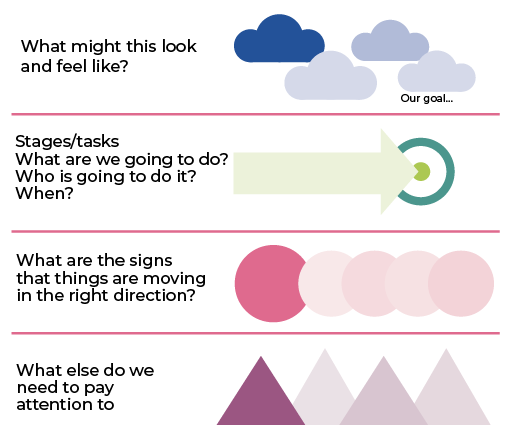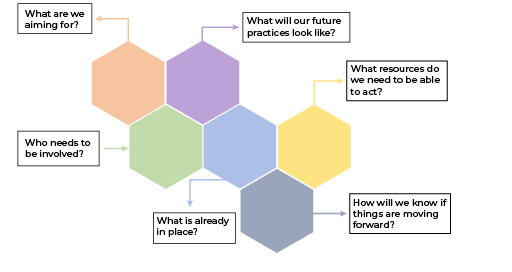4 Moving towards an imagined future
The next phase of the appreciative inquiry process is to begin to put some plans into action. One way of doing this would be to use a basic model of change management in which goals (or design statements) are agreed and team(s) are charged with the task of planning for implementation. But, in an appreciative inquiry approach, the need to retain a spirit of improvisation and generativity requires a different way of thinking. This involves making a clear distinction between planning the steps and creating the conditions for change. Bushe and Kassam (2005) demonstrate that lasting transformation is more likely when improvisation is a characteristic of the action phase.
Creating appreciative cultures in which generative actions are possible can be a challenging proposition, but Bushe (2007) identifies four key principles that might reflect such a culture:
- Collective agreement refers to the important role of the immersing and dreaming phases in building understanding and ownership of the inquiry focus.
- Authorised action involves ensuring that everyone has the authority to take actions that will move things forward in the agreed direction of travel.
- Creating commitments involves creating clear opportunities for everyone to take an initial action that commits them to the process of change.
- ‘Tracking and fanning’ requires us to ‘look for any and all acts that move the organisation in the desired direction and find ways to support and amplify those efforts’ (p. 6).
These principles offer a stark contrast to the more ‘top-down’ approach to managing change that we might be most familiar with. Collective agreement about a desired future reality emerges from the earliest phases of an appreciative inquiry. What Bushe and Kassam (2005) establish is the importance of maintaining generativity in the innovation and design phase. This involves creating a climate where groups and individuals are able to take action without the need to resort to committees, because a shared commitment and understanding enables movement towards the envisaged new reality. This allows for emergent and improvisatory action that remains responsive to the realities, rather than working towards a set of pre-determined, fixed goals.
Such an approach reflects Holman’s (2010, 2013) work on how scientific research on complex adaptive systems can be applied to organisational development. As a result she encourages us to embrace ‘nature’s way of changing’ (Holman 2013, p. 19) which involves us in working with complexity, disruption and messiness which emerge from change processes. In practice, this means that, instead of restraining and resisting disturbance, it can be welcomed and used in a creative dance with order to find emergent opportunities when inquiry meets real life. Plans and fixed outcomes can be held lightly, focusing instead on intentions and pursuing the possibilities that seem to lead most positively towards the desired future.
Activity 6 Creating the conditions for action
Instead of creating an action plan, which can feel fixed, we are going to create a ‘gameplan’ to highlight the conditions we need for acting towards our positive future. Either use one of the example gameplan templates below (Figures 5 and 6) or devise your own format. Avoid using tables in your document and make it as inviting and easy to engage with as possible, as this is going to be used as a poster that you can display or keep close throughout your inquiry actions.
Simple is often best!
To help you, use the following prompts:
- Write down as simply as you can what you are aiming for. This may come from your provocative proposition in Activity 3.
- Note down what initial step you (or each of you) are going to commit to taking.
- Describe what you hope or imagine your future practices will look, sound and feel like in a few words.
- What environments, resources, materials do you need to be able to take action?
- What is already in place to support you?
- What permissions or support do you need and from whom, to be able to act, respond and/or improvise as the inquiry proceeds?
- Who else needs to be involved in the action to make it successful?
- How will you know if things are moving forwards?
- How will you evidence what happens as a result?
Whilst your ‘gameplan’ will have some specific and quite concrete actions, it is important to remember that you are not trying to capture everything that will happen – you need to leave space for responding and improvising to what happens along the way, focusing instead on the conditions we need for us to act.
Comment
You may have found the process of creating a gameplan challenging as you may have realised that you don't have the ideal conditions in place for an appreciative inquiry to occur. In some ways this is always true of inquiry processes and part of making inquiry work is creating the best possible conditions that you can and acknowledging where conditions could be better. Completing this activity has hopefully made you aware of what you might be able to put in place to create the best possible conditions you can.
An important aspect of planning for and enacting inquiry is how we ensure we are acting ethically in collaboration. The next section will explore what this means in practice.


